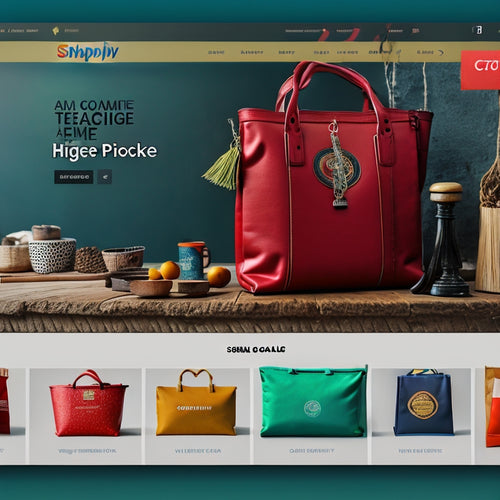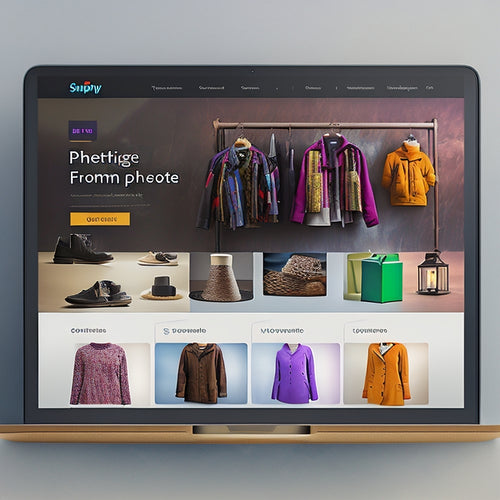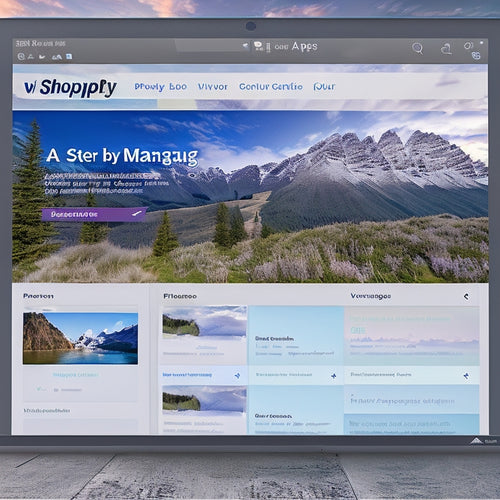
7 Essential Tips for Seamless Online Course Delivery
Share
To guarantee seamless online course delivery, you'll want to start by defining clear learning objectives that align with your curriculum. Next, choose a platform that meets your course needs and offers reliable support. Then, create engaging content that incorporates storytelling and interactive elements to captivate your students. Don't forget to optimize your course page design for a user-friendly experience and guarantee seamless payment processing. Additionally, leverage student feedback loops and monitor progress through analytics to make data-driven decisions. By following these essential tips, you'll be well on your way to creating a student-centric experience that sets your course up for success. Now, let's dive deeper into each of these critical components.
Key Takeaways
• Define clear learning objectives and measurable outcomes to guide course development and delivery.
• Choose a user-friendly platform that supports interactive content and provides seamless payment processing.
• Develop engaging course content with storytelling techniques and interactive elements to enhance student experience.
• Monitor student progress and feedback to refine course content and identify areas for improvement.
• Ensure accessibility and inclusivity by providing support for diverse learning styles and disabilities.
Define Clear Learning Objectives
To ensure your online course stays focused and effective, you need to establish clear learning goals that outline what students will be able to do or achieve by the end of the course. This is the foundation of a well-structured online course, and it's vital to get it right.
When you establish clear learning goals, you're able to create a curriculum map that aligns with the skills and knowledge you want your students to acquire. This, in turn, informs your assessment planning, ensuring that you're measuring the right outcomes.
By doing so, you'll be able to determine whether your students have achieved the desired learning goals, and make adjustments to your course as necessary. Effective outcome measurement is crucial to the success of your online course, and it all starts with clear learning goals.
Choose the Right Platform Fit
With a clear direction set by your learning objectives, you now need to select a platform that will effectively support your online course's unique needs and facilitate a seamless learning experience for your students.
To do this, you'll need to conduct a thorough platform comparison, considering factors such as user experience, features, and technical support. Assess the features of each platform, asking yourself questions like: Does it allow for interactive content? Can it handle large file uploads? Are there built-in collaboration tools?
Evaluate the technical support offered, including response times, documentation, and community resources. You want a platform that will provide reliable and efficient support when you need it.
Develop Engaging Course Content
When developing engaging course content, you'll want to focus on crafting learning objectives that truly resonate with your students. You can do this by making them specific, measurable, and achievable, which will help you create a clear roadmap for your course.
Craft Compelling Learning Objectives
By defining clear and measurable learning goals, you'll set the foundation for creating engaging course content that resonates with your students. This essential step ensures you're focused on what students need to achieve, making it easier to assess outcomes and measure success.
Well-crafted goals also boost student engagement and motivation levels, as they provide a clear direction and purpose.
To craft compelling learning goals, start by identifying the key skills or knowledge you want students to acquire. Make sure they're specific, achievable, relevant, and time-bound (SMART).
For example, 'By the end of this module, students will be able to analyze financial data to inform business decisions.' This goal is clear, measurable, and achievable, giving students a sense of accomplishment when they meet it.
Use Storytelling Techniques
You'll capture your students' attention and foster a deeper connection with your course material by incorporating storytelling techniques into your content. Storytelling is an effective way to convey complex information in a relatable and memorable way. By sharing personal anecdotes, case studies, or hypothetical scenarios, you can create an emotional connection with your students, making the learning experience more engaging and enjoyable.
To use storytelling effectively, try to create a narrative arc that takes your students on a journey. Start with a hook that grabs their attention, build tension or suspense, and then resolve the story with a clear takeaway or lesson. This will help your students remember the key concepts and apply them to real-life situations.
Ensure Seamless Payment Processing
Around 80% of online course enrollments are abandoned due to payment processing issues, making it crucial to ensure seamless payment processing to avoid losing potential students.
You don't want to lose a customer at the finish line, do you? To guarantee a smooth payment experience, prioritize payment security. Make sure your payment gateway is secure and trustworthy, with an SSL certificate and compliance with industry standards like PCI-DSS. This will give your students peace of mind, knowing their sensitive information is protected.
Next, focus on user experience. A complicated or confusing payment process can be a major turnoff. Make sure your payment process is intuitive and easy to navigate. Use clear and concise language, and minimize the number of steps required to complete the payment. You should also provide multiple payment options to cater to different student preferences.
Optimize Course Page Design
Now that you've established a seamless payment experience, it's time to focus on creating a course page design that effectively communicates the value of your online course and motivates students to enroll.
A well-designed course page can make all the difference in converting visitors into students. To achieve this, consider the principles of color psychology to evoke emotions and create a lasting impression. Use a palette that resonates with your target audience and aligns with your brand identity.
When it comes to user experience, prioritize clarity and simplicity. Make sure your course page has a clear visual hierarchy, guiding visitors' attention to the most important information. Select a font that's easy to read, both on desktop and mobile devices, and use headings to break up content and create a clear structure.
This will help students quickly grasp the value of your course and encourage them to enroll. By optimizing your course page design, you'll create a powerful first impression, boost engagement, and ultimately drive more sales.
Leverage Student Feedback Loops
When you leverage student feedback loops, you're actively listening to your students' opinions and concerns, which helps you pinpoint areas where your online course might be falling short.
By doing so, you'll identify pain points that need attention, whether it's a confusing lesson or a technical issue.
Tune in to Opinions
Tune in to Opinions
By actively seeking feedback from your students, you can identify and address any issues or misconceptions early on, ultimately leading to a more effective online learning experience. This is vital in building a strong feedback response, which helps you refine your course content and teaching methods. Additionally, it fosters community engagement, encouraging students to take an active role in their learning journey.
Here are some ways to effectively tune in to your students' opinions:
| Feedback Channel | Frequency | Purpose |
|---|---|---|
| Surveys | Weekly/Bi-Weekly | Identify areas of improvement |
| Discussion Forums | Ongoing | Encourage community engagement |
| One-on-One Meetings | Monthly | Address individual concerns |
Identify Pain Points
By analyzing the feedback you've collected, you can pinpoint specific pain points that are hindering your students' progress, allowing you to make targeted adjustments to your course content and instruction. This is where you get to dig deep and identify areas where your students are struggling. Are they having trouble with student engagement, or are technology challenges holding them back?
Take a close look at the feedback and identify patterns. Are there certain topics or modules where students are consistently struggling? Are there specific technology tools or platforms that are causing frustration? By pinpointing these pain points, you can make informed decisions about how to revamp your course to better meet the needs of your students.
For instance, if you notice that students are struggling with a particular concept, you can create additional resources, such as video tutorials or interactive quizzes, to help them better understand the material.
Or, if technology challenges are hindering student engagement, you can explore alternative platforms or tools that are more user-friendly. By addressing these pain points, you can create a more seamless and effective learning experience for your students.
Refine the Experience
Now that you've identified the pain points in your online course, it's time to refine the experience by leveraging student feedback loops to create a continuous improvement cycle.
You've taken the first step towards creating a seamless online course experience, and now it's time to amplify your efforts.
To truly refine the experience, you need to listen to your students and act on their feedback. This won't only improve engagement but also enhance communication between you and your students.
Here are three ways to make it happen:
-
Regular Check-Ins: Schedule regular check-ins with your students to gather feedback and concerns. This can be done through surveys, discussion forums, or one-on-one meetings.
-
Open Communication Channels: Encourage students to reach out to you directly with questions or concerns. Make sure to respond promptly and address their issues efficiently.
-
Data-Driven Decisions: Analyze student feedback and course data to identify areas of improvement. Use this information to make data-driven decisions that will refine the online course experience.
Monitor Progress and Analytics
Tracking student progress and analytics is essential to understanding how your online course is performing and identifying areas for improvement. By monitoring student progress, you'll gain valuable insights into what's working and what's not, allowing you to make data-driven decisions to enhance the learning experience.
To get the most out of your analytics, you need to analyze data and track trends. This will help you identify patterns in student behavior, such as which topics they're struggling with or which content they're engaging with the most. By doing so, you can refine your course content, adjust your teaching methods, and optimize the overall learning experience.
Additionally, you'll be able to identify potential issues early on, such as low engagement or poor quiz performance, and take corrective action to get students back on track. By monitoring progress and analytics, you'll be empowered to make informed decisions, improve student outcomes, and deliver a more effective online course.
Frequently Asked Questions
How Do I Handle Copyright Issues With Course Materials?
When using copyrighted materials, you'll want to familiarize yourself with fair use guidelines and Creative Commons licenses to guarantee you're not infringing on anyone's rights, and avoid costly legal issues down the line.
Can I Reuse Course Content From Previous Years?
Did you know 80% of online learners reuse course materials? You can too, but make sure you update content to keep it fresh and relevant, incorporating new engagement strategies to boost learner interest and participation.
What Is the Ideal Course Duration for Online Learners?
When determining the best course duration, you're aiming for a duration that balances student engagement with thorough learning. Aim for modules lasting 30-60 minutes, allowing learners to focus without feeling overwhelmed.
How Do I Prevent Cheating on Online Course Assessments?
You'll prevent cheating on online course assessments by implementing proctoring solutions, ensuring academic honesty, and setting clear expectations; this way, you'll maintain the integrity of your online courses and uphold the value of your students' hard-earned credentials.
What Are the Accessibility Requirements for Online Courses?
'Imagine students stumbling through your course like tourists in a foreign land - don't let that happen! You guarantee equal access by incorporating accommodation accommodations and inclusive design strategies, making your course a welcoming, accessible oasis for all.'
Related Posts
-

How Do I Rank High on Shopify
This article aims to provide an informative and data-driven overview of strategies for achieving a high ranking on S...
-

How Do I Use the Shopify Bundles App
The following article aims to provide a comprehensive understanding of the utilization of the Shopify Bundles App fo...
-

Installing Private Shopify Apps: A Step-by-Step Guide
This article presents a comprehensive guide on the installation process of private Shopify apps. Private apps, disti...


